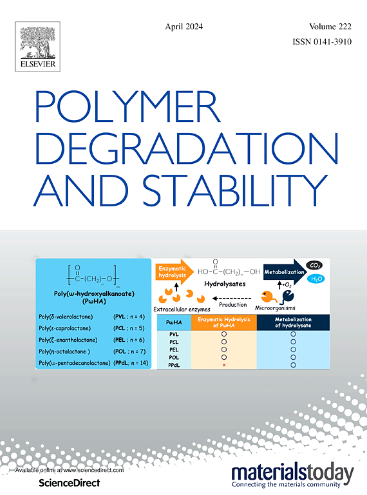Ti3SiC2 改性碳纤维/硼酚醛树脂可陶瓷化复合材料的烧蚀行为与机理
IF 7.4
2区 化学
Q1 POLYMER SCIENCE
引用次数: 0
摘要
碳纤维/酚醛树脂复合材料容易发生氧化失效。在这项工作中,制备了具有优异抗氧化腐蚀性和抗烧蚀性的 Ti3SiC2 改性碳纤维/硼酚醛树脂可陶瓷化复合材料。该复合材料具有近乎零的烧蚀特性,在 3000 °C 下 20 秒的线性烧蚀率为 -0.00859 mm/s。根据烧蚀行为、微观结构演变、相演变和热力学分析研究了烧蚀机理。通过牺牲 Ti3SiC2,在烧蚀过程中原位构建了由含碳多相陶瓷组成的热保护屏障,发挥了耗氧、抑氧、自愈、固碳和反应吸热的功能。本文章由计算机程序翻译,如有差异,请以英文原文为准。
Ablation behavior and mechanism of Ti3SiC2 modified carbon fiber/boron phenolic resin ceramizable composite
Carbon fiber/phenolic resin composite is prone to oxidation failure. In this work, Ti3SiC2 modified carbon fiber/boron phenolic resin ceramizable composite with excellent oxidation corrosion and ablation resistance was fabricated. It exhibited near-zero ablation characteristics with the linear ablation rate at 3000 °C for 20 s being -0.00859 mm/s. The ablation mechanism was investigated based on the ablation behavior, microstructure evolution, phase evolution and thermodynamic analysis. A thermal protection barrier composed of carbon-containing multiphase ceramics was in-situ constructed during ablation by sacrificing Ti3SiC2 and exerting the functions of oxygen consumption, oxygen inhibition, self-healing, carbon fixation and reaction heat absorption.
求助全文
通过发布文献求助,成功后即可免费获取论文全文。
去求助
来源期刊

Polymer Degradation and Stability
化学-高分子科学
CiteScore
10.10
自引率
10.20%
发文量
325
审稿时长
23 days
期刊介绍:
Polymer Degradation and Stability deals with the degradation reactions and their control which are a major preoccupation of practitioners of the many and diverse aspects of modern polymer technology.
Deteriorative reactions occur during processing, when polymers are subjected to heat, oxygen and mechanical stress, and during the useful life of the materials when oxygen and sunlight are the most important degradative agencies. In more specialised applications, degradation may be induced by high energy radiation, ozone, atmospheric pollutants, mechanical stress, biological action, hydrolysis and many other influences. The mechanisms of these reactions and stabilisation processes must be understood if the technology and application of polymers are to continue to advance. The reporting of investigations of this kind is therefore a major function of this journal.
However there are also new developments in polymer technology in which degradation processes find positive applications. For example, photodegradable plastics are now available, the recycling of polymeric products will become increasingly important, degradation and combustion studies are involved in the definition of the fire hazards which are associated with polymeric materials and the microelectronics industry is vitally dependent upon polymer degradation in the manufacture of its circuitry. Polymer properties may also be improved by processes like curing and grafting, the chemistry of which can be closely related to that which causes physical deterioration in other circumstances.
 求助内容:
求助内容: 应助结果提醒方式:
应助结果提醒方式:


